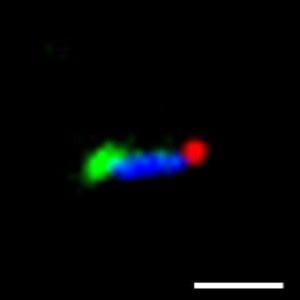May 30 2019
In the future, DNA assembled into nanostructures—for example, tubes and origami-inspired shapes—could be used in applications ranging from DNA computers to nanomedicine.
 Repair molecules (green dye) can self-heal a DNA nanotube (blue dye); the red dye is the “seed” used to create the nanotube. Scale bar, 2 microns. (Image Credit: Adapted from Nano Letters, 2019, DOI: 10.1021/acs.nanolett.9b00888)
Repair molecules (green dye) can self-heal a DNA nanotube (blue dye); the red dye is the “seed” used to create the nanotube. Scale bar, 2 microns. (Image Credit: Adapted from Nano Letters, 2019, DOI: 10.1021/acs.nanolett.9b00888)
However, these interesting structures do not endure for a long time in biological environments due to enzymes known as nucleases that disintegrate DNA. Currently, scientists have developed DNA nanostructures that can repair themselves in serum. The study outcomes have been published in ACS’ journal Nano Letters.
In the future, doctors could bring DNA nanostructures into the human body to diagnose diseases or dispense medications, among other applications. However, firstly, they must seek a solution to protect or repair the molecules when nucleases attack. Scientists have devised many methods to stabilize the structures in serum, for example, chemically modifying or coating the DNA. However, it can be time-consuming and expensive to make this stabilized DNA, and the alterations could influence the nanostructures’ biocompatibility or function. Hence, Yi Li and Rebecca Schulman intended to create a self-repair process that could considerably prolong the lifetime of DNA nanostructures.
The scientists designed DNA nanotubes that assemble themselves from smaller DNA “tiles.” In serum, the nanostructures disintegrated in just 24 hours at body temperature. However, when the scientists added additional tiles to serum comprising of the nanotubes, the building blocks healed damaged structures, prolonging their lifetimes to over 96 hours.
By labeling the original nanotubes and the additional tiles with differently colored fluorescent dyes, the group established that the extra small DNA pieces repaired the degrading structures by replacing damaged tiles as well as by attaching to the ends of the nanotube. The scientists created a computer model of the process that showed DNA nanostructures could be maintained for months or more with the help of the self-healing technique.
The authors recognize funding from the Defense Advanced Research Projects Agency.